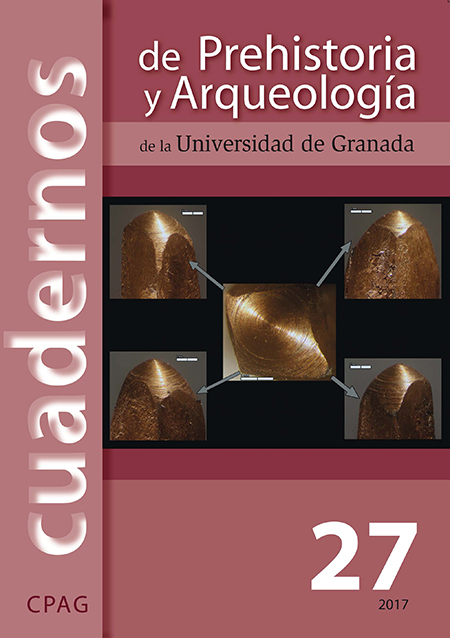LA COMPLEJIDAD DE LAS HUELLAS DE USO EN PUNTAS DE PROYECTIL DE SÍLEX – UNA CONTRIBUCIÓN PARA EL DEBATE
Contenido principal del artículo
Resumen
En este artículo describimos un experimento programado para proporcionar pautas para una clasificación detallada de las huellas de uso generadas en las puntas de proyectil de sílex por golpeo sobre una variedad de materiales orgánicos y no orgánicos. Veri- ficamos los resultados existentes y prestamos especial atención al daño microscópico (retoques, pulido y estrías). La lista de trazas características de las puntas de proyectil se estableció principalmente sobre la base de la morfología (observaciones microscó- picas actuales) y solo indirectamente a partir de las clasificaciones funcionales. En el transcurso del experimento se utilizaron 122 réplicas de puntas de flecha: 33 puntas, 31 puntas de flecha con retoque bifacial, 26 trapecios y 16 puntas de flecha compuestas (realizada cada una mediante la inserción de una punta y una barba lateral). Nuestra clasificación incluye 22 rasgos de diagnóstico, divididos en 4 grupos principales: fracturas, retoque, pulido y estriaciones. Entre las fracturas, las más características fueron los astillamientos complejos, así como ciertos tipos de fracturas con retoque (especialmente las producidas con levantamiento de esquirlas). Entre los retocados y los aplastados, los más abundantes mostraban fracturas burilantes y negativos de esquirlas, aunque retoques denticulados, astillados postimpacto y astillados del astil se consideraron importantes. También se prestó atención a los retoques en el filo que no se encuentran en otros tipos de útiles funcionales. Entre los diferentes tipos de pulidos, se prestó especial atención a los producidos como resultado de la rápida fricción del útil contra un material duro en el punto de impacto. Se dio una gran im- portancia al pulido lineal y al extenso; también se consideraron significativos los tipos específicos de pulido en aristas y bordes. Se encontró que las huellas lineales son de poca utilidad para la interpretación de la función de las inserciones de los proyecti- les. Nuestras observaciones sugieren que la identificación de puntas de proyectiles prehistóricos puede requerir un análisis mucho más preciso que los realizados hasta ahora. Depender únicamente de los tipos básicos de estigmas posteriores al impacto es inadecuado. Las huellas de este tipo solo están presentes en un pequeño porcentaje del número total de inserciones. Además, algunos tipos de ellas se formaron solo en circunstancias específicas, en las que tanto el tipo de punta de flecha como el tipo de blanco tenían importancia.



